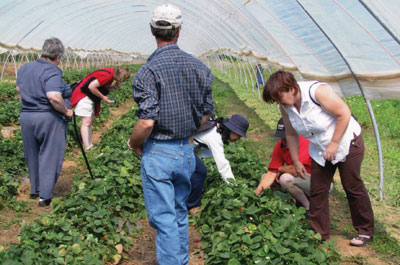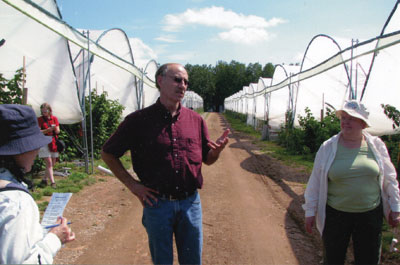
Features
Production
Research
Atlantic growers learn about extending the berry season
January 12, 2010 By Dan Woolley
This year’s Horticulture Nova Scotia-Agra Point berry crop tour focused on season extension, a guaranteed attention getter for berry producers based in a province noted for its short seasons.
This year’s Horticulture Nova Scotia-Agra Point berry crop tour focused
on season extension, a guaranteed attention getter for berry producers
based in a province noted for its short seasons.
The first stop of the tour was at the New Ross, N.S., farm of Glen
Higbee, one of the earliest adapters of day neutral cultivation in the
province. Higbee explained he turned to day neutral strawberries as an
alternative niche crop when he established his farm 14 years ago. He
realized he could not compete against the longtime Annapolis Valley
berry producers.
Higbee picks his day neutral strawberries over a three-month season
that ends in late October. He extends his production season by using
Typar row covering stretched on small hoops over the plants.
He considers the Seascape variety as the standard for day neutral
strawberries, adding it has made a big difference to his production.
He’s also found that Albion, a newer day neutral variety, needs lots of
nitrogen, which can make the variety susceptible to rot when it is
raised under black plastic mulch.
The more nitrogen the grower applies, the worse the rot becomes in
Albion, stated Higbee, while the Pacific variety tends to go yellow
when it doesn’t receive enough nitrogen.
Seascape also has a powdery mildew problem but Higbee has found good
control with the use of Pristine. After throwing away 5,000 quarts of
Pacific strawberries, he has learned to use Cabrio to control
anthracnose, which can overwinter in his berry plots.
Higbee says it can be hard to maintain berry quality the first few
years after the plants are put in. Currently, he harvests about 12,000
quarters per acre, noting the fruit came on slower this past season but
the flavour was better.
Weed control is maintained by applying Sinbar between the berry rows
and by mowing the walkway area of the field in the early spring using a
lawn mower. Higbee also lays straw between his day neutral strawberry
rows to slow the weeds and place organic matter back into the soil. The
straw also helps to keep the berries clean from mud splashes.
He fertilizes his berry plantings with composted chicken manure applied at a rate of two tons per acre.
Higbee estimates he has cut his planting costs in half by using a
mechanized hole punch to plant his berry plugs through the plastic
mulch covering the rows.
 |
|
| Berry tour visitors examine day neutral strawberries growing under low tunnels at Josh Oulton’s Taproot Farms. (Photos by Dan Woolley) |
Taproot Farms
At Taproot Farms in Canard, N.S., Josh Oulton grows Seascape day
neutrals in low tunnels using a plastic mulch system with drip
irrigation. He began picking this year on May 22, stopped July 10, and
then resumed picking at the start of August.
Oulton had “a huge issue” with two-spotted spider mites when he first
started berry production in low tunnels four years ago. He decided to
apply a beneficial predator product – Spidex – and re-applied it this
spring. His mite problem has not returned.
“I haven’t put a miticide on for two years,” he said. “They have done a wonderful job on the mites.”
Oulton also planted Albion and gave the planting “a good drink of
compost tea” after hilling the plants. He fertigates his berries with
3-18 and 8-0-0-10 while going easy on the calcium. He also uses seaweed
extract to stimulate microbial activity in the soil.
“Strawberries like a highly fungal soil, so I make everything as fungal as I can.”
Botrytis and grey mould issues in the plantings are controlled using Lance and Captan sprays.
Production rates were about 12,000 quarts per acre during the season.
Oulton’s father-in-law, Andrew Bishop, of Noggins Corner Farm, has a
half-acre of raspberries under two, 350-foot-long high tunnels.
His four raspberry varieties – Nova, Boyne, Killarney and Autumn
Britten – have been grown in tunnels for two years. Bishop is excited
about the system, believing the tunnels are a real plus for “managing
my labour and my crop and there is a lot more marketable yield.” He
adds that he has had tremendous success with the quality and taste of
his berries, which is showing up in the price he’s receiving for his
product.
After using the tunnels, Bishop has decided to continue growing
raspberries. He has gained another seven to eight days in the growing
season by applying the plastic on the tunnels earlier in the year.
 |
|
| Ron Turner, soft fruit co-ordinator with Vital Berries, explains how Nova Agri Group manages its raspberry production under high tunnels.
|
Vital Berries
In 2007 at its Centreville, N.S., location, the Vital Berries division
of the Nova Agri Group set up eight acres of high tunnels for the
production of Autumn Britten raspberries.
It was a learning experience. In 2008, they had to adjust the
fertigation levels because the berries were over-ripe and didn’t travel
well to market after picking, explained Ron Turner, Nova Agri’s soft
fruit co-ordinator.
Since then, Vital Berries has planted four tunnels with the variety
Caroline for summer and fall fruit production and planted four rows of
Anne, a yellow summer berry. Each tunnel is 310 feet long and 28 feet
wide and contains four rows of plants.
According to Turner, fertigation “tweaking” continues to be an issue.
Mites and root weevil are controlled in row using beneficial nematodes,
he explained, adding that fungicides are applied every seven to 10 days
and calcium is used during the early bloom period to optimize berry
shelf life.
This summer, between July 16 and Aug. 1, Vital Berries produced 4,000
flats of summer berries. Having the fruit mature, and be picked and
shipped at the right time for the customers, was the big issue, said
Gary Hart, site manager.
“There is still a lot to learn,” said Turner. “Nothing yet is black and white.”
Print this page